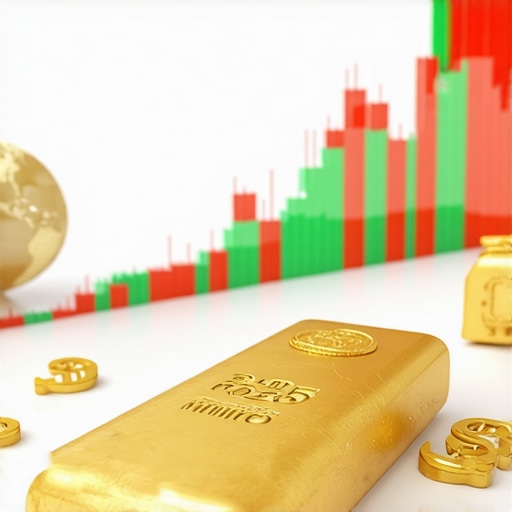Understanding Gold Demand Trends: A Glimpse into the Future
As we navigate through an ever-evolving economic landscape, understanding gold demand trends becomes imperative for both seasoned investors and newcomers alike. Gold has historically been viewed as a safe haven asset, particularly during times of economic uncertainty. The impact of inflation, geopolitical tensions, and fluctuations in currency values significantly influence its demand and price. In this article, we will explore the key factors shaping the future of gold demand and what they mean for your investment strategies.
What Factors Influence Gold Demand?
Several critical factors affect the demand for gold. Economic indicators such as inflation rates, interest rates, and currency stability play a significant role. For instance, historically, when inflation rises, many investors flock to gold as a hedge against devaluation. According to the World Gold Council, demand for gold typically increases during periods of economic instability.
Another essential aspect to consider is the cultural significance of gold in various regions. In countries like India and China, gold is not only an investment but also a vital part of cultural traditions, especially during festivals and weddings. This cultural demand adds a layer of complexity to understanding gold’s overall market dynamics.
How Will Future Economic Trends Affect Gold Demand?
Looking ahead, experts predict that the demand for gold will remain robust. The future economic trends, including ongoing inflation and central bank policies, will likely keep gold in a favorable position. As central banks accumulate gold reserves, this activity can signal confidence in gold as a long-term investment.
Moreover, as the world continues to grapple with uncertainties, such as the potential fallout from geopolitical conflicts and climate change, gold’s status as a safe-haven asset is expected to solidify. Investors seeking stability may increasingly turn to gold, which can lead to rising prices and demand.
What Should You Do in Response to These Trends?
For individuals interested in investing in gold, keeping an eye on gold demand trends is crucial. Understanding how external factors influence gold prices can help you make informed decisions about your investments. Whether you’re considering physical gold or gold ETFs, it’s essential to align your strategy with current market insights.
As we look to the future, remember that staying informed is key. Subscribe to our newsletter for the latest insights on gold market trends!
What are your thoughts on the future of gold demand? Share your insights in the comments below!
Shifts in Global Economic Power and Their Impact on Gold Demand
As the global economic landscape shifts, emerging markets are becoming increasingly significant players in the gold market. Nations such as India and China are not only large consumers of gold but are also ramping up their production and investment strategies. The Wikipedia entry on gold investment highlights how these countries view gold as both a cultural asset and a financial safeguard, particularly amidst economic instability. This cultural appreciation for gold contributes to a sustained demand that transcends mere investment, reinforcing its role in the global economy.
How Do Central Banks Influence Gold Demand?
Central banks are pivotal in shaping gold demand trends. With a growing number of central banks diversifying their reserves by accumulating gold, the asset’s appeal as a reliable store of value continues to rise. These purchases signal confidence in gold’s stability, especially during periods of market volatility. According to recent reports, central banks have been net buyers of gold, reflecting a strategic move to bolster their financial security.
For investors, this trend indicates that gold may be viewed as a hedge against economic downturns. If central banks prioritize gold in their reserves, it potentially elevates gold’s status and drives up demand. Investors should closely monitor these developments, as they may offer insights into future price movements and the overall health of the gold market.
The Role of Technological Advancements in Gold Trading
Another factor influencing gold demand is the advancement of technology in trading practices. Online platforms have made it easier for retail investors to buy and sell gold, democratizing access to this precious metal. With just a few clicks, investors can engage in gold trading, whether through gold ETFs or physical gold purchases.
Moreover, innovations such as blockchain technology are beginning to transform how gold is traded and tracked, enhancing transparency and security in transactions. As technology continues to evolve, it is likely to play a significant role in the accessibility and efficiency of gold trading, thus potentially increasing demand.
What Should Investors Watch for in Gold Demand Trends?
Investors should keep an eye on several key indicators that could influence gold demand. Economic reports, geopolitical developments, and shifts in monetary policy are all critical factors to watch. Additionally, understanding consumer behavior in key markets can provide insights into future demand trends. For instance, an increase in gold purchases during wedding seasons in India can be a bellwether for future price movements.
Ultimately, staying informed about these trends will help investors make strategic decisions regarding their gold investments. Engaging with resources like our guide on gold market analysis can provide valuable insights to navigate the complexities of gold investing.
What are your thoughts on the evolving landscape of gold demand? We’d love to hear your insights! Share your comments below.
The Impact of Geopolitical Tensions on Gold Demand Trends
As global tensions rise, the demand for gold often experiences a corresponding increase. Investors view gold as a safe-haven asset during periods of instability, leading to fluctuations in its price based on geopolitical events. Historical data shows that significant events, such as conflicts, trade wars, and political unrest, can drive up gold prices as investors seek to protect their wealth. Understanding these dynamics is crucial for anyone looking to navigate the gold market effectively.
How Do Geopolitical Events Influence Gold Prices?
Geopolitical events can create uncertainty, prompting investors to move towards assets perceived as stable, such as gold. For instance, according to the World Gold Council, during periods of heightened tension, such as the U.S.-China trade disputes or conflicts in the Middle East, gold prices often surge as investors rush to safeguard their assets.
Additionally, the behavior of major economies plays a significant role in shaping gold demand. For example, if a country is involved in military conflict, the resulting economic sanctions and instability can lead to a decrease in confidence in that nation’s currency, further spurring demand for gold. This reaction highlights how interconnected global events are with gold’s market dynamics.
What Other Factors Should Investors Consider?
While geopolitical tensions are a significant driver of gold demand, other factors also come into play. Central bank policies, interest rates, and inflation rates are critical elements that can affect gold prices. For example, low interest rates often lead to increased gold purchasing since the opportunity cost of holding gold diminishes.
Moreover, investor sentiment and market psychology cannot be overlooked. When fear or uncertainty prevails, more investors flock to gold, thereby increasing its demand. Keeping an eye on economic indicators, such as inflation and employment rates, can provide insights into potential shifts in gold demand.
People Also Ask: How Can I Prepare for Gold Investment Amidst Uncertainty?
Preparing for gold investment during uncertain times involves several strategic steps. First, it’s essential to stay informed about geopolitical developments, as these can influence market trends. Regularly reviewing gold price forecasts can also offer valuable insights into future trends.
Additionally, diversifying your gold investments can help mitigate risks. Consider a mix of physical gold, gold ETFs, and other gold-related assets to create a balanced portfolio. This approach can protect your investments from sudden market shifts while capitalizing on gold’s potential as a stable asset.
In conclusion, understanding how geopolitical tensions and other factors influence gold demand is vital for making informed investment decisions. As you stay aware of these trends, consider exploring our guide on effective gold market analysis for deeper insights.
What are your thoughts on investing in gold during uncertain times? Share your insights in the comments below!
Understanding the Role of Economic Indicators in Gold Demand
As we delve deeper into gold demand trends, it is essential to recognize how economic indicators serve as a compass for investors. Economic growth rates, unemployment levels, and consumer confidence indices can significantly impact the demand for gold. For instance, during economic downturns, gold often becomes a favored asset, as investors seek stability in uncertain times.
Furthermore, the Investopedia highlights that rising inflation typically drives demand for gold. As the purchasing power of currency diminishes, gold is perceived as a hedge against inflation, leading to increased investment in this precious metal.
How Does Interest Rate Policy Affect Gold Demand?
Interest rates are another crucial element influencing gold demand. When central banks maintain low-interest rates, the opportunity cost of holding non-yielding assets like gold decreases, making it more attractive. Conversely, higher interest rates can deter investment in gold, as they often signal a strengthening economy and can lead to a stronger dollar.
For example, after the Federal Reserve raised rates in the past, gold prices often experienced downturns. Therefore, monitoring central bank announcements and interest rate forecasts is vital for investors looking to time their gold investments effectively.
The Impact of Inflation on Gold Demand in 2025
As we approach 2025, the impact of inflation on gold demand is expected to remain pronounced. The persistent rise in consumer prices can lead to an increased appetite for gold as a protective measure against eroding purchasing power. Historically, during periods of high inflation, gold has proven to be a reliable store of value, prompting investors to allocate more of their portfolios to this precious metal.
What Should Investors Know About Gold as an Inflation Hedge?
Investors should be aware that gold tends to outperform other assets during inflationary periods. As commodities become more expensive, gold not only retains its value but often appreciates, making it a crucial component of an inflation-hedged portfolio. Understanding the relationship between inflation and gold can empower investors to make informed decisions and adjust their strategies accordingly.
Given these dynamics, it is prudent to start considering gold investment options if inflationary pressures are anticipated. Whether through gold mutual funds or physical gold, aligning your investment strategy with expected economic conditions can enhance your portfolio’s resilience.
Engaging with Gold Investment Strategies: A Call to Action
As we continue to explore the intricacies of gold demand trends, staying engaged with the market is crucial. Consider subscribing to our newsletter for ongoing updates, expert insights, and strategies tailored for 2025. By doing so, you can remain ahead of the curve and make well-informed decisions regarding your gold investments.
What strategies are you considering to capitalize on gold demand trends? Share your thoughts in the comments below!
Frequently Asked Questions (FAQ)
What are the main factors that influence gold demand?
The primary factors influencing gold demand include economic indicators such as inflation rates, currency stability, and geopolitical events. Cultural significance in regions like India and China also plays a vital role in driving demand.
How does inflation affect gold prices?
Inflation typically leads to higher gold prices as investors seek gold as a hedge against currency devaluation. Historically, during periods of rising inflation, gold tends to retain or appreciate in value.
What role do central banks play in gold demand?
Central banks significantly impact gold demand by accumulating gold reserves as a strategic move to bolster their financial security. Their purchases often signal confidence in gold as a stable asset during economic uncertainty.
How can investors prepare for potential fluctuations in gold demand?
Investors should diversify their portfolios by including a mix of physical gold, gold ETFs, and gold mutual funds. Staying informed about economic indicators and geopolitical events can also help in making strategic investment decisions.
What are some common gold investment strategies?
Common strategies include investing in physical gold, gold ETFs, and mutual funds. Investors should consider their risk tolerance, market conditions, and economic forecasts when choosing their investment approach.
How do technological advancements impact gold trading?
Technological advancements, such as online trading platforms and blockchain technology, have made gold trading more accessible and transparent, likely increasing demand as retail investors engage more easily in the market.
What is the relationship between gold and geopolitical tensions?
Gold is often viewed as a safe-haven asset during geopolitical tensions. Historical trends show that gold prices tend to rise during conflicts or political unrest as investors seek stability.
Are gold ETFs a good investment option?
Gold ETFs can be an excellent investment option for those looking to gain exposure to gold without the complexities of owning physical gold. They offer liquidity, ease of trading, and the ability to diversify investments effectively.
How can I stay updated on gold market trends?
To stay informed about gold market trends, consider subscribing to newsletters, following reputable financial news sources, and engaging with expert analyses on platforms dedicated to gold investment.
Authoritative Sources
The following sources provide valuable insights and data related to gold demand trends and investment strategies:
World Gold Council – A leading authority on gold investment, offering comprehensive research and insights into gold demand trends.
Investopedia – Provides educational content and analysis on financial topics, including gold investment and market dynamics.
Gold.org – Offers industry data and reports on gold supply and demand, helping investors make informed decisions.
Conclusion
Understanding gold demand trends is essential for making informed investment decisions in today’s dynamic economic environment. With factors such as inflation, geopolitical tensions, and central bank policies influencing the market, staying abreast of these trends is crucial. As you navigate your gold investment strategies, consider diversifying your portfolio and leveraging resources available to stay informed. Engage with our community by sharing your thoughts on gold investments in the comments below, and subscribe for ongoing updates and insights!









